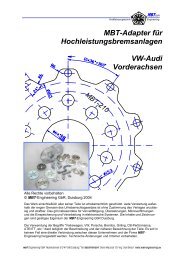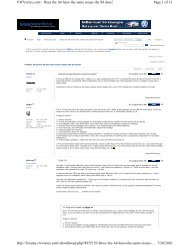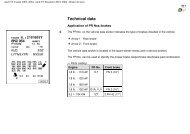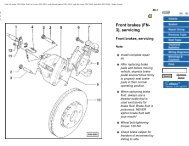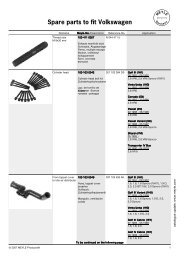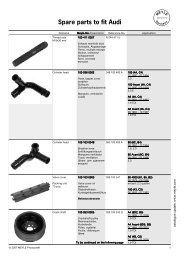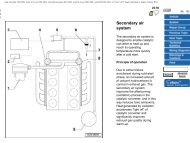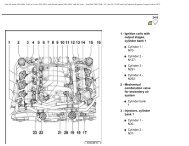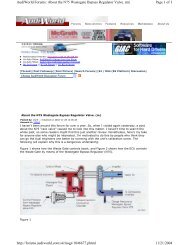VW MKII A2 MK2 Golf Jetta Fox Service Manual - VAGLinks.com
VW MKII A2 MK2 Golf Jetta Fox Service Manual - VAGLinks.com
VW MKII A2 MK2 Golf Jetta Fox Service Manual - VAGLinks.com
Create successful ePaper yourself
Turn your PDF publications into a flip-book with our unique Google optimized e-Paper software.
2A•10 Engine repair procedures - 1.05 and 1.3 litre pre August 1985<br />
13 If possible, <strong>com</strong>pare the length of the<br />
valve springs with new ones and renew them<br />
as a set if any are shorter.<br />
14 If the engine is still in the vehicle, clean the<br />
piston crowns and cylinder bore upper edges<br />
but make sure that no carbon drops between<br />
the pistons and bores. To do this, locate two<br />
of the pistons at the top of their bores and<br />
seal off the remaining bores with paper and<br />
masking tape. Press a little grease between<br />
the two pistons and their bores to collect any<br />
carbon dust which can be wiped away when<br />
the piston is lowered. To prevent carbon<br />
build-up, polish the piston crown with metal<br />
polish but remove all traces of the polish<br />
afterwards.<br />
12 Timing belt and sprockets -<br />
removal 3<br />
1 If the engine is still in the vehicle, first carry<br />
out the following operations:<br />
a) Disconnect the battery negative lead<br />
b) Remove the air cleaner<br />
c) Remove the alternator drivebelt<br />
2 Turn the engine until the indentation in the<br />
camshaft sprocket appears in the TDC hole in<br />
the timing cover and the notch in the<br />
crankshaft pulley is aligned with the TDC<br />
pointer on the front of the oil pump.<br />
3 Unbolt and remove the timing cover, noting<br />
that the dipstick tube and earth lead are fitted<br />
to the upper bolts. On some later 1.3 litre<br />
models, it is necessary to remove the<br />
crankshaft pulley to remove the lower timing<br />
belt cover.<br />
4 Loosen the coolant pump retaining bolts,<br />
then turn the pump body clockwise to release<br />
the tension from the timing belt. Remove the<br />
timing belt from the camshaft sprocket (see<br />
illustration).<br />
5 Using an Allen key, unbolt the pulley from<br />
the crankshaft sprocket then remove the<br />
timing belt.<br />
6 To remove the camshaft sprocket, unscrew<br />
the bolt and remove the spacer. Tap off the<br />
sprocket and remove the Woodruff key. Do<br />
not turn the camshaft. The sprocket can be<br />
held stationary using a metal bar with two<br />
bolts, with one bolt inserted through a<br />
13.2 One method of holding the flywheel<br />
stationary<br />
12.4 Releasing timing belt from camshaft<br />
sprocket<br />
sprocket hole and the other bolt resting on the<br />
outer rim.<br />
7 To remove the crankshaft sprocket,<br />
unscrew the bolt and lever the sprocket from<br />
the crankshaft (see illustration). Do not turn<br />
the crankshaft otherwise the pistons may<br />
touch the valve heads. Hold the crankshaft<br />
stationary with a lever inserted in the starter<br />
ring gear (remove the starter as applicable).<br />
Remove the Woodruff key.<br />
13 Flywheel - removal<br />
3<br />
1 Remove the clutch.<br />
2 Hold the flywheel stationary with a lever or<br />
angle iron (see illustration) engaged with the<br />
starter ring gear.<br />
3 Unscrew the bolts and lift the flywheel from<br />
the crankshaft (see illustration).<br />
4 Remove the engine plate from the cylinder<br />
block (see illustration).<br />
5 The flywheel bolts must be renewed once<br />
they are removed.<br />
14 Crankshaft oil seals - renewal<br />
Front seal<br />
3<br />
1 Remove the crankshaft sprocket.<br />
2 If available, use <strong>VW</strong> tool 2085 to remove the<br />
seal from the oil pump housing. Removal of<br />
12.7 Removing crankshaft sprocket bolt<br />
and washer<br />
the seal with the engine and oil pump in<br />
position in the vehicle can prove difficult<br />
without the special tool. In this instance, an<br />
alternative method is to drill two holes,<br />
diagonally opposed to each other in the seal,<br />
insert two self-tapping screws and then pull<br />
on the screws using grips to withdraw the<br />
seal. If using this method, care must be taken<br />
not to drill into the housing.<br />
3 If the oil pump is removed from the engine,<br />
the seal can be prised out and a new item<br />
fitted - see illustration 31.1.<br />
4 Clean the recess in the oil pump.<br />
5 Smear a little clean engine oil on the lip and<br />
outer edge of the new seal, then fit it with <strong>VW</strong><br />
tool 10-203 or by tapping it in with a suitable<br />
metal tube .<br />
6 Refit the crankshaft sprocket.<br />
Rear seal<br />
7 Remove the flywheel.<br />
Method 1<br />
8 Drill two diagonally opposite holes in the<br />
seal. Insert two self-tapping screws and pull<br />
out the seal with grips.<br />
9 Clean the recess in the housing.<br />
10 Smear a little clean engine oil on the lip<br />
and outer edge of the new seal then tap it into<br />
the housing using a suitable metal tube<br />
11 Refit the flywheel.<br />
Method 2<br />
12 Remove the sump.<br />
13 Unscrew the bolts and withdraw the<br />
housing from the dowels on the cylinder<br />
block. Remove the gasket (see illustrations).<br />
13.3 Removing flywheel 13.4 Removing engine plate<br />
1081 <strong>VW</strong> <strong>Golf</strong> & Jeta



